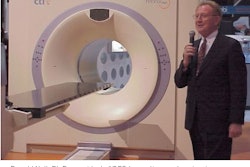CHICAGO - Identifying malignancies such as peritoneal metastases from ovarian cancer is a difficult task, as the nodes are often very small and difficult to detect by cross-sectional imaging alone. The use of CT for detecting this type of cancer has been well investigated, as has stand-alone PET imaging. However, the combination of the two technologies with PET/CT fusion imaging could provide the best possible imaging study for the detection of ovarian cancer.
Dr. Harpreet Pannu from Johns Hopkins Medical Institutions, Baltimore, presented the results of research she and her colleagues performed to show how PET/CT fusion images could improve diagnoses of ovarian cancer to attendees at the 88th annual RSNA.
“PET/CT has a very high sensitivity for detecting disease and is very specific,” Pannu said.
The researchers retrospectively reviewed both PET and PET/CT exams (10 PET and 33 PET/CT) performed on 28 patients with ovarian cancer between April 2000 and March 2002. The PET scans were performed on a GE Medical Systems Waukesha, WI) Advance PET scanner, and the fusion scans were conducted on a Discovery LS, also from GE.
The results were correlated with surgery, serum CA125 levels, and routine CT, when available. The PET scans were performed by injecting 15 mCi of FDG intravenously and imaging after one hour. For patients who had PET/CT, the CT was performed prior to the PET with 5 mm thick sections at 4.25 mm intervals without oral or intravenous contrast.
In both systems, tomographic images were obtained from the skull base to the mid-thigh. The CT images were used for PET interpretation and were reviewed separately. Two diagnostic radiologists, one experienced in PET imaging and one musculoskeletal radiologist experienced in genitourinary imaging reviewed the PET and the CT images, respectively.
For the 10 PET scans, follow-up was surgical in two cases, contrast-enhanced CT in six, and CA125 levels in five. No follow up was available in 3 cases, all with negative PET. The findings were true positive in three cases, true negative in two, and false positive in two, Pannu said. She reported that the group found sensitivity was 100% (3/3) and the specificity was 50% (2/4).
For the 33 PET-CT scans, follow-up was surgical in 8 cases, contrast-enhanced CT in 18, and CA125 levels in 20. No follow-up was available in four cases, two with negative PET, and two with positive PET. The findings were true positive in 14 cases, true negative in 10, and false negative in five cases, Pannu noted. The sensitivity was reported as 73.6% (14/19) and specificity as 100% (10/10).
In 25 cases, the findings of the PET and CT portions of the PET/CT scan were congruent. In five cases, PET was true positive while the CT portion of the PET/CT scan was negative. A routine CT with contrast was also performed in four patients and showed disease in three, with one negative. In two cases, the PET was false negative while the CT of the PET-CT scan was positive. In one case of a negative PET and a positive CT, there was no follow up, Pannu reported.
“Our research shows the value of fused FDG-PET-CT scans as a fairly sensitive and highly specific technique for detecting peritoneal metastases from ovarian cancer vs. FDG-PET imaging alone,” Pannu said.
She noted that although the study population was small, review of the PET scan in conjunction with CT images appears to improve specificity over review of just PET images. And, even though the CT portion of the PET/CT scan is appropriate for localization, it may not demonstrate lesions seen on routine contrast-enhanced CT, she observed.
By Jonathan S.
Batchelor
AuntMinnie.com staff writer
December 6, 2002
Copyright © 2002 AuntMinnie.com




















